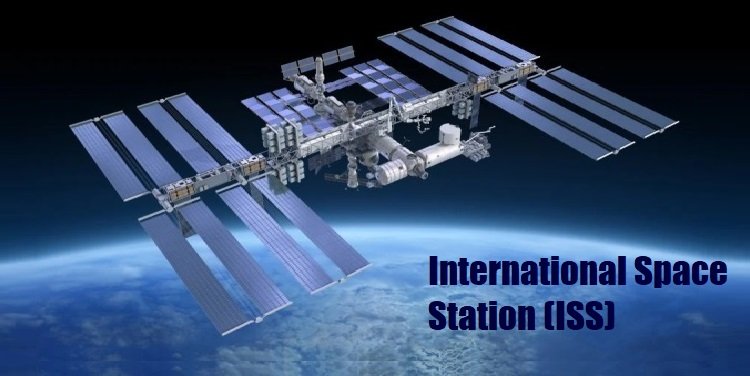International Space Station (ISS): History, Structure, Purpose & Future

The International Space Station (ISS) is one of the greatest achievements in space exploration and international cooperation. Orbiting about 400 kilometers (250 miles) above Earth, the ISS serves as a unique laboratory where astronauts from around the world conduct scientific research in a microgravity environment. Since its first module was launched in 1998, the ISS has been a symbol of unity, technological advancement, and human ambition to explore the unknown.
 History and Construction
History and Construction
The ISS began as a joint project between NASA (USA), Roscosmos (Russia), ESA (Europe), JAXA (Japan), and CSA (Canada). The first part of the station, the Russian module Zarya, was launched in November 1998. Since then, multiple modules and components have been added, creating a football-field-sized structure in space.
The construction of the ISS was completed over more than a decade with the help of over 30 missions involving astronauts, spacecraft, and powerful rockets. It is considered one of the most expensive and ambitious engineering projects ever undertaken.
 Structure and Features
Structure and Features
The ISS is made up of multiple interconnected modules that serve different purposes:
- Living Quarters: Where astronauts eat, sleep, and exercise.
- Laboratories: For conducting scientific experiments in physics, biology, medicine, and technology.
- Solar Arrays: Large panels that provide electrical power using sunlight.
- Docking Ports: For visiting spacecraft from various space agencies.
The station orbits the Earth every 90 minutes, which means astronauts experience 16 sunrises and sunsets each day.
 Purpose and Scientific Research
Purpose and Scientific Research
The ISS is a space-based laboratory that enables long-term research in a low-gravity environment. Some major areas of study include:
- Human health and biology in space
- Materials science and how different substances react in microgravity
- Climate and Earth observation
- Technological testing for future missions to the Moon and Mars
The knowledge gained from ISS research has contributed to improvements in medicine, environmental monitoring, and engineering on Earth.
 International Cooperation
International Cooperation
One of the most remarkable aspects of the ISS is the collaboration among nations. Despite political differences on Earth, space agencies have worked together to build, maintain, and operate the ISS. This partnership has fostered peace, shared scientific advancement, and cultural exchange among astronauts.
 Future of the ISS
Future of the ISS
The ISS is expected to remain operational until at least 2030, after which some parts may be retired or handed over to commercial companies. Meanwhile, new space stations are being planned by countries like China, and private firms like Axiom Space and SpaceX are developing new modules and habitats for space tourism and research.
The International Space Station stands as a beacon of what humanity can achieve when we unite for a common goal. It has expanded our understanding of life beyond Earth and continues to inspire future generations of scientists, engineers, and explorers. As we prepare for more ambitious missions to the Moon and Mars, the legacy of the ISS will continue to guide and support our journey into the cosmos.

अंतरराष्ट्रीय अंतरिक्ष स्टेशन (ISS) अंतरिक्ष अनुसंधान और अंतरराष्ट्रीय सहयोग की एक महान उपलब्धि है। यह पृथ्वी से लगभग 400 किलोमीटर (250 मील) ऊपर कक्षा में चक्कर लगाता है। आईएसएस एक अनोखी प्रयोगशाला के रूप में कार्य करता है जहाँ विभिन्न देशों के अंतरिक्ष यात्री सूक्ष्म गुरुत्वाकर्षण (microgravity) में वैज्ञानिक अनुसंधान करते हैं। 1998 में इसके पहले मॉड्यूल के प्रक्षेपण के बाद से, आईएसएस एकता, तकनीकी प्रगति और अंतरिक्ष की खोज में मानव आकांक्षा का प्रतीक बन गया है।
 इतिहास और निर्माण
इतिहास और निर्माण
आईएसएस की शुरुआत नासा (अमेरिका), रॉसकोसमोस (रूस), ईएसए (यूरोप), जैक्सा (जापान) और सीएसए (कनाडा) के संयुक्त प्रोजेक्ट के रूप में हुई थी। इसका पहला हिस्सा, रूसी मॉड्यूल जार्या (Zarya), नवंबर 1998 में लॉन्च हुआ। इसके बाद कई मॉड्यूल और हिस्से जोड़े गए, जिससे यह अंतरिक्ष में एक फुटबॉल मैदान जितना बड़ा ढांचा बन गया।
आईएसएस का निर्माण दस से अधिक वर्षों में 30 से ज्यादा मिशनों की मदद से पूरा हुआ, जिसमें अंतरिक्ष यात्री, यान और शक्तिशाली रॉकेट शामिल थे। यह अब तक के सबसे महंगे और जटिल इंजीनियरिंग प्रोजेक्ट्स में से एक माना जाता है।
 संरचना और विशेषताएँ
संरचना और विशेषताएँ
आईएसएस कई जुड़े हुए मॉड्यूल से बना है जो विभिन्न कार्यों के लिए हैं:
- रहने के क्वार्टर: जहाँ अंतरिक्ष यात्री खाते, सोते और व्यायाम करते हैं।
- प्रयोगशालाएँ: जहाँ भौतिकी, जीवविज्ञान, चिकित्सा और तकनीकी प्रयोग होते हैं।
- सौर पैनल: जो सूर्य की रोशनी से बिजली बनाते हैं।
- डॉकिंग पोर्ट्स: जहाँ विभिन्न देशों के अंतरिक्ष यान जुड़ते हैं।
यह स्टेशन हर 90 मिनट में पृथ्वी की एक परिक्रमा करता है, जिससे अंतरिक्ष यात्री दिन में 16 बार सूर्योदय और सूर्यास्त देखते हैं।
 उद्देश्य और वैज्ञानिक अनुसंधान
उद्देश्य और वैज्ञानिक अनुसंधान
आईएसएस एक अंतरिक्ष-आधारित प्रयोगशाला है जो कम गुरुत्वाकर्षण में लंबे समय तक अनुसंधान की सुविधा देती है। मुख्य अनुसंधान क्षेत्रों में शामिल हैं:
- अंतरिक्ष में मानव स्वास्थ्य और जीवविज्ञान
- पदार्थों का व्यवहार सूक्ष्म गुरुत्वाकर्षण में
- जलवायु और पृथ्वी का अवलोकन
- तकनीकी परीक्षण, भविष्य के चंद्रमा और मंगल अभियानों के लिए
आईएसएस पर हुआ अनुसंधान चिकित्सा, पर्यावरण और इंजीनियरिंग के क्षेत्र में पृथ्वी पर भी उपयोगी साबित हुआ है।
 अंतरराष्ट्रीय सहयोग
अंतरराष्ट्रीय सहयोग
आईएसएस की सबसे खास बात यह है कि यह विभिन्न देशों के सहयोग से बना है। पृथ्वी पर राजनीतिक मतभेद होने के बावजूद, अंतरिक्ष एजेंसियों ने मिलकर इस स्टेशन का निर्माण, संचालन और रखरखाव किया है। इस साझेदारी ने शांति, वैज्ञानिक प्रगति और सांस्कृतिक आदान-प्रदान को बढ़ावा दिया है।
 आईएसएस का भविष्य
आईएसएस का भविष्य
आईएसएस के 2030 तक संचालन में रहने की संभावना है। इसके बाद या तो इसे चरणबद्ध तरीके से बंद किया जाएगा या निजी कंपनियों को सौंप दिया जाएगा। इस बीच, चीन जैसे देश और Axiom Space, SpaceX जैसी निजी कंपनियाँ भी अपने-अपने अंतरिक्ष स्टेशन या मॉड्यूल विकसित कर रही हैं, जिससे भविष्य में अंतरिक्ष पर्यटन और अनुसंधान को बढ़ावा मिलेगा।
अंतरराष्ट्रीय अंतरिक्ष स्टेशन इस बात का प्रमाण है कि जब मानवता एकजुट होती है तो असंभव को भी संभव बनाया जा सकता है। इसने हमें पृथ्वी के बाहर जीवन को समझने का मौका दिया है और आने वाली पीढ़ियों को विज्ञान और अंतरिक्ष की ओर प्रेरित किया है। जैसे-जैसे हम चंद्रमा और मंगल की ओर कदम बढ़ा रहे हैं, आईएसएस की विरासत हमारे अंतरिक्ष मिशनों को दिशा और समर्थन देती रहेगी।
More GK Topics:






